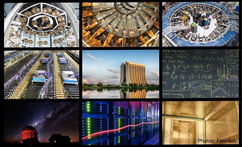Speaker
Description
Many astrophysical observations point to the abundant existence of dark matter in the Universe. However, despite numerous experiments using different techniques, dark matter particles have yet to be directly observed. The Super Cryogenic Dark Matter Search experiment (SuperCDMS) uses silicon and germanium detectors operated at temperatures as low as 15 mK in the low-background environment at the SNOLAB underground laboratory (Sudbury, Canada) to probe dark matter interactions using phonon and ionization signals. The primary dark matter candidate for the SuperCDMS experiment are weakly interacting massive particles (WIMPs) with masses masses ≲ 10 GeV$/c^{2}$ which recoil from crystal nuclei. Single electron-hole pair resolution has been recently achieved using gram-sized R&D detectors operated at high voltage. By searching for dark matter-electron interactions, they have been used for searches of low-mass dark matter candidates such as dark photons and Light Dark Matter. Highlights of these results using extremely low thresholds and an overview of the SuperCDMS experiment will be presented.
